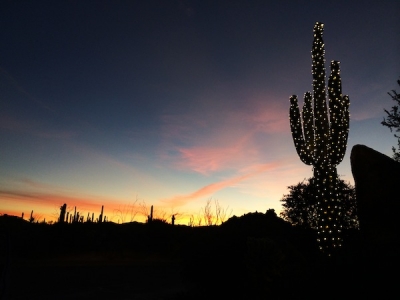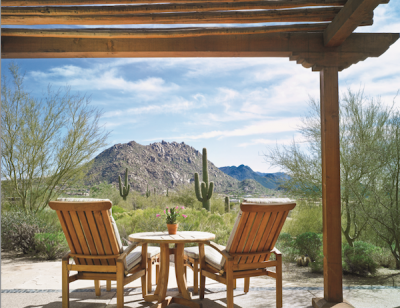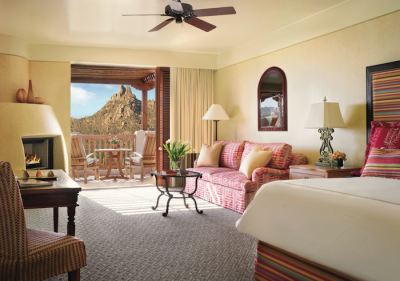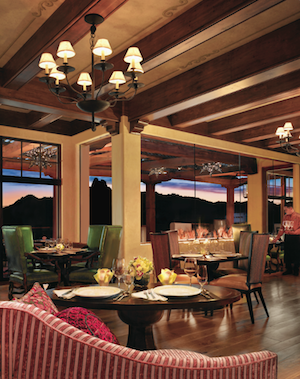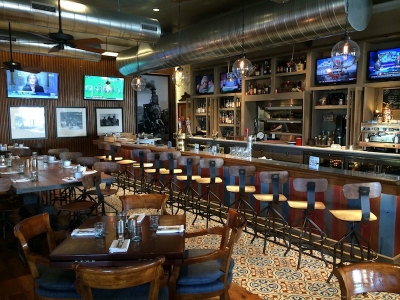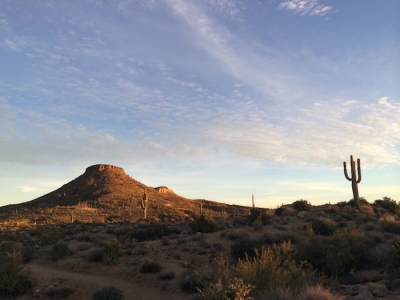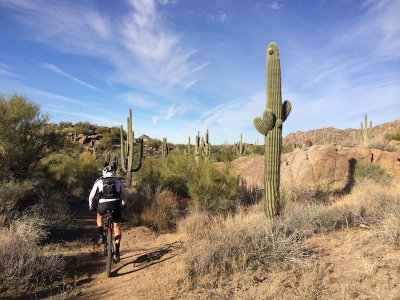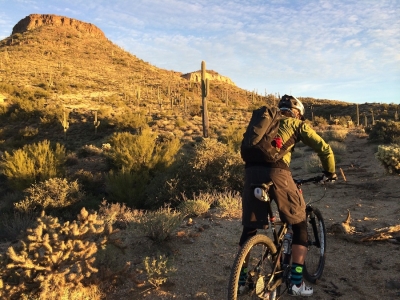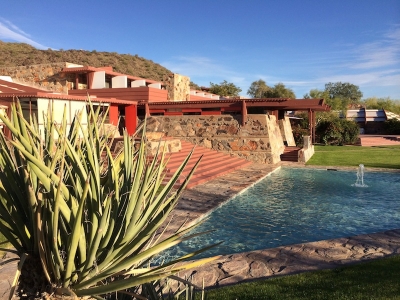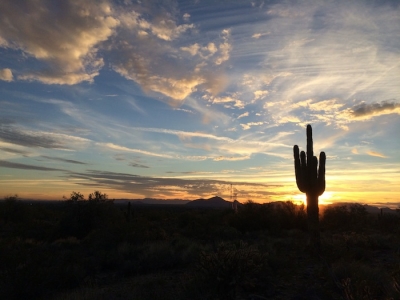
Four Seasons Resort Scottsdale at Troon North
One of Scottsdale Four Seasons’ charms is that at times it becomes downright invisible. Designed by HKS architects, the property’s adobe hacienda style blends effortlessly with the Sonoran desert landscape. The emphasis is clearly placed where it’s most needed – on the land.
Tan stepped walls front patios and alcoves crowned by rough-hewn arbors. The minimalist design is an optimal match for the ruddy earth that towers with iconic saguaro cactus – and above, blue skies 300+ days a year darkening to rose and purple as stars emerge. There are, in fact, telescopes in all 22 suites. Plus, there’s complimentary stargazing each Friday night at 2,651 feet above sea level.
The property’s 40 acres harbor 210 guest rooms, and some suites have outdoor garden showers, private plunge pools, indoor fireplaces and outdoor kiva fireplaces. At night there’s the sumptuous smell of wood smoke from potbelly stoves placed around the grounds.
The requisite pool (6,000 square-feet), underwent a $1 million restoration in 2010. And nearby: two on-site Nova Pro tennis courts, and a 12,000-square-foot spa and fitness center with 14 treatment rooms.
The lobby and and front desk are decked in a tweaked Southwestern style, splashed with bold and neon prints. A design standout is the tapestry-like front curtains with Huichol-beaded accents flowing to three tiers of torn fringe.
The resort’s signature restaurant is Talavera, a steakhouse with views so vast it’s hard to concentrate on the food. But perhaps more impressive is Proof, a home-style canteen with a comfort level that will make it damn hard to get out and enjoy all that gorgeous desert scenery.
The Four Seasons recently renovated the space at a cost of $2.5 million and it shows. The eclectic décor starts with a recessed railroad track that traverses the central floor, anchored by wheeled tables. There’s country store ornamentation, and even a soda jerk. The food starts with addictive pretzel knots. For breakfast try the chocolate bacon waffles or smoked brisket hash, and for lunch or dinner: fried green tomatoes, lobster roll, chicken and waffles, and grilled peach with arugula salad, among others.
And yes, the sous chef drives a 1957 Ford pick-up.
You don’t need to wander far from Four Seasons for a great night out and meal – Sassi is just around the corner. You could even walk – in fact it’s advisable if you lack a designated driver. Arizona has one of the toughest DUI/DWI laws on the books, with mandatory jail times for even first time offenders.
Sassi has a darkly romantic feel, starting with the moodily lit stone and wood exterior – old world architecture inspired by Southern Italy. The interior nearly looks like a set piece, with near endless rooms and dining alcoves. The menu is extensive. My favorite: butternut squash risotto and the pan seared sea scallops. There’s also a family style “Little Italy” dinner available that starts with antipasti and ends with gelato.
Desert Adventures
Golf is a huge draw in these parts, and Four Seasons guests have priority use of the Pinnacle and Monument championship courses at Troon North, including run of the 37,000-square-foot clubhouse. That helped Four Seasons Scottsdale earn the 2011 ranking of “75 Best Golf Resorts in North America,” by Golf Digest magazine. There are 51 golf courses, citywide.
An avid hiker and mountain biker, I took to rockier courses. Much of the Four Seasons’ property surveys Pinnacle Peak and its 150-acre park. In fact there’s a trail leading straight from the property up to the peak. The 1.75-mile trail is a moderate, up-and-back hike with an elevation gain of about 1,300 feet.
The McDowell Sonoran Preserve is a 15-minute drive away and features 100 miles of hiking and mountain biking trails. I took a three-hour mountain bike journey, expertly guided by Arizona Outback Adventures. You can hire a guide, or just rent a bike from AOA.
We packed a comb and tweezers in case of a cactus crash – and even duct tape, used to remove smaller spines. Despite some speedy downhill descents, the kit was gratefully not needed. Still, the Sonoran Desert is harsh as well as stunningly beautiful. The terrain is alien, otherworldly: oversized saguaro cactus stand like mute sentinels; jumping cholla cactus glow with morning light that fills innumerable long, hollow spines.
A rare rain had fallen the night before, so my 7 a.m. ride was rife with the smell of creosote, that burnt-smoky odor so common to Arizona deserts. Although the trails are well marked, for my first journey, I was happy to have a guide.
Guides can also be hired for hiking tours and adventures on the Salt and Verde rivers (AOA and Mild to Wild Rafting.) The Grand Canyon is about three and one-half miles away; Sedona about two hours; and Lake Powell, about four and one-half hours.
Also available in Scottsdale: rock climbing, off-road tours, horseback riding and hot air ballooning via Hot Air Expeditions or Rainbow Ryders.
Architecture from A to Z
Frank Lloyd Wright made Scottsdale his winter home, partly because of health issues. He termed the area his “grand garden,” drawn to the rough landscape and stark views. His keen interest helped spur decades of cutting-edge design that continues today.
Wright built Taliesin West on the outskirts of Scottsdale, occupying it during winters from 1937 until his death in 1959. The property now operates as the Frank Lloyd Wright School of Architecture and is open for public tours.
The home opens to the vast Paradise Valley. Built from desert rocks piled in wood forms and filled with concrete, the home’s rough style is finished (or was finished) by redwood beams. In the harsh heat, the redwood eventually retained dry rot, and in recent decades has been replaced by either Douglas fir or steel.
The home is at once beautiful, raw, harsh, stunning and at times just seems wrong (such as the redwood choice, along with an emerald carpet of grass baking beneath the desert sun) – as well as arrogantly, stubbornly very much Wright. Lesson: Damn the critics. Build your vision. Public tours range from one to three hours long.
Former Wright student Paolo Soleri’s studio can also be toured. Cosanti, a jumble of Hobbit-like structures, was built nearly sixty years ago. It yet operates as a foundry, producing hundreds of Soleri’s popular ceramic and bronze wind bells. You can watch workers out back as they smash steaming molds to release the finished bells.
The Soleri Bridge and Plaza that spans the ancient Arizona canal is a highlight among numerous public work projects. The smokestack-like pylons are dramatically lit at night, tilted back and straining against steel cables that support the bridge.
Another Wright apprentice, Edward L. Varney, designed the mid-century modern landmark Hotel Valley Ho in 1956. The hotel was meticulously restored in 2005 at a cost of $80 million, and has been termed the finest example of authentic mid-century modern design found in a hotel today.
The impression of other Wright students –John Gardiner, Hiram Hudson Benedict and Vernon Swaback – can be found in spas, resorts, and ranches. Peruse Scottsdale’s architecture site for more information on tours and locations.
Central Scottsdale
Scottsdale is small enough (225,000) to grasp, especially given its sprawling Big Brother Phoenix to the southwest. But it packs plenty in its 184 square miles.
In brief, here are my recommendations: Desert Botanical Garden, the Arts District and Thursday night Art Walk, public art (Scottsdale has one of the best public art programs in the U.S.), the American Indian riches of the Heard Museum, and the Downtown Trolley that will ferry you for free to many central sites, including Old Town Scottsdale.
Fortunate for tourists, Scottsdale has a top-rate convention and visitor’s bureau, its website broken down into near endless choices and niche markets, a great tool when planning a visit.
Also, peruse the Four Seasons Resort Scottsdale at Troon North website.




